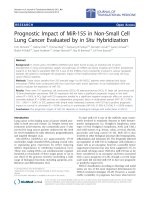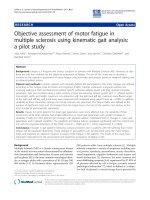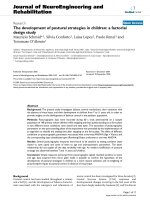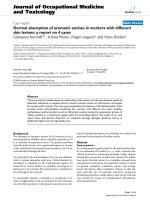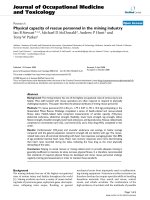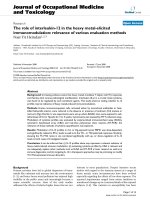Báo cáo hóa học: " Nonlinear dynamics of non-equilibrium holes in p-type modulation-doped GaInNAs/GaAs quantum wells" pdf
Bạn đang xem bản rút gọn của tài liệu. Xem và tải ngay bản đầy đủ của tài liệu tại đây (537.87 KB, 5 trang )
NANO EXPRESS Open Access
Nonlinear dynamics of non-equilibrium holes in
p-type modulation-doped GaInNAs/GaAs
quantum wells
Hagir Mohammed Khalil
1*
, Yun Sun
1
, Naci Balkan
1
, Andreas Amann
2
, Markku Sopanen
3
Abstract
Nonlinear charge transport parallel to the layers of p-modulation-doped GaInNAs/GaAs quantum wells (QWs) is
studied both theoretically and experimentally. Experimental results show that at low temperature, T = 13 K, the
presence of an applied electric field of about 6 kV/cm leads to the heating of the high mobility holes in the
GaInNAs QWs, and their real-space transfer (RST) into the low-mobility GaAs barriers. This results in a negative
differential mobility and self-generated oscillatory instabilities in the RST regime. We developed an analytical model
based upon the coupled nonlinear dynamics of the real-space hole transfer and of the interface potential barrier
controlled by space-charge in the doped GaAs layer. Our simulation results predict dc bias-dependent self-
generated current oscillations with frequencies in the high microwave range.
Introduction
During the past d ecade, dilute nitrides, particularly the
quaternary material system of GaInNAs/GaAs, have
attr acted a great deal of attention, both because of unu-
sual physica l properties and potential applications for a
variety of optoelectronic devices. The addition of a small
amount of nitrogen induces a strong pe rturbation in the
conduction band of matrix semicond uctors, while hav-
ing a negligible effect on the valence band. As a result,
theelectronmobilityisgreatlyloweredandthehole
mobility can become higher than the electron mobility,
in materials with relatively high nitrogen content. High
hole mobility coupled with the low hole confinement
energy (110 meV in our calculation for the samples
investigated in this study) [1] in the GaInNAs/GaAs
quantum well (QW) structure makes it possible for
holes in the well to gain enough energy to overcome the
small band discontinuity under an electric field applied
parallel to the layer interface, and to transfer into the
low-mobility p-doped GaAs layer. This leads to a nega-
tive differential mobility (NDM) caused by real-space
hot hole transfer, as we previously observed [1]. T here-
fore, under dc conditions, a self-generated current
oscillation in the real-space regime, as proposed by
Schöll and co-authors [2-5], is expected in p-modula-
tion-doped GaInNAs/GaAs heterostructures.
In this work, we study the nonlinear charge transport
in a modulation-doped GaInNAs/GaAs semiconductor
heterostructure where the GaAs barrier layer is inten-
tionally p-doped. The charge transport processes per-
pendicular and parallel to the layers far from
thermodynamic equilibrium are modeled by several
coupled nonlinear dynamics equations. In this model,
self-generated current oscillations can be described in
the following way. Real-space transfer (RST) of holes
out of the GaInNAs well layer leads to an increase of
the hole density in the GaAs barrier, which diminishes
the negative space charge that controls the band bend-
ing (Figure 1). Consequently, the potential barrier F
B
decreases, with some delay due to the finite dielectric
relaxation time. This leads to an increased thermionic
emission ba ckward current J
b-w
into the GaInNAs well,
which decreases the hole density in the GaAs barrier.
As a r esult, the space charge and F
B
are increased in
the GaAs. This, in turn, decreases the thermionic emis-
sion backward current from the well into the barrier [6].
* Correspondence:
1
School of Computer Science and Electronic Engineering, University of Essex,
CO4 3SQ, Colchester, UK
Full list of author information is available at the end of the article
Khalil et al. Nanoscale Research Letters 2011, 6:191
/>© 2011 Khalil et al; licensee Springer. This is an Open Access article distributed under the terms of the Creative Commons Attribution
License ( which perm its unrestricted u se, distribution, and reproduction in any medium,
provide d the original work is properly cited .
Negative differential resistance instabilities in p-
modulation-doped GaInNAs/GaAs QWs
The layer structure of the sample used in this study is
given in Table 1. The sample, which was grown by
molecular beam epitaxy (MBE) on semi-insulating GaAs
substrate, consists of three 7 nm thick GaInNAs QWs,
separated by 20 nm thick Be-doped GaAs barriers.
These p-type-doped barriers are separated from the
QWs by 5 nm undoped spacer layers to reduce the
remote impurity scattering. The mole fraction of indium
and nitrogen in the Ga
1-x
In
x
N
y
As
1-y
QWs is x = 0.3 and
y = 0.015, respectively. The sample was fabricated in the
shape o f a simple bar for I-V measurement. Fabrication
details are given somewhere else [1].
The nonlinear transport processes depicted in Figure 1
are modeled by a set of dynamic equations relevant to
current instabilities in semiconductors. We derive a set
of nonlinear partial differential equations for the h ole
density in the wells (p
w
), and in the barriers (p
b
), the
potential barrier in each of GaAs layers (F
B
), and the
dielectric relaxation of the applied parallel field (ξ
II
).
The dynamics of the carrier density in the well and in
the barrier are given by [5]
∂
∂
=−
()
−−
p
tqL
JJ
w
w
wb bw
1
(1)
∂
∂
=−
()
−−
p
tqL
JJ
b
b
bw wb
1
(2)
where J
w-b
and J
b-w
are the thermionic currents flow-
ing from the GaInNAs well layers to the GaAs barrier
and from the barrier into the well, re spectively, q is
the positive electron charge, an d L
w
and L
b
are the
widthoftheGaInNAsQWandtheGaAsbarrier,
respectively. The electric field parallel to the layer
interface ξ
II
can be derived from Poisson’ sequation
and is given by
0 s
II
wb
Abbww
y
q
LL
NpLpL
∂
∂
=
+
−
()
+
⎡
⎣
⎤
⎦
(3)
where ε
0
and ε
s
are the absolute and relative permit-
tivity, respectively. Using Equations (1)-(3), the dielec-
tric relaxation of the applied parallel field ξ
II
as a
function of the current flow (y-direction), the trans-
verse space coordinator (x-direction), and the time t
can be written as
0
1
s
II
wb
b
b
w
w
wb
dy t
q
LL
dp
dt
L
dp
dt
L
q
LL q
∂∂
∂
⎛
⎝
⎜
⎞
⎠
⎟
=
−
+
+
⎡
⎣
⎢
⎤
⎦
⎥
=
+
−
LL
JJ
p
x
L
qL
JJ
b
bw wb b
bII
b
w
wb bw w
−−
−−
−
()
+
∂
∂
⎡
⎣
⎢
⎤
⎦
⎥
+
⎡
⎣
⎢
⎢
−
()
+
()
1
∂∂
∂
⎡
⎣
⎢
⎤
⎦
⎥
⎤
⎦
⎥
⎥
()p
x
L
wII
w
(4)
=−
()
−
+
−
∂
∂
⎡
⎣
⎢
⎤
⎦
⎥
+
∂
∂
⎡
⎣
⎢
⎤
⎦
⎥
LII
wb
bbb
II
www
II
LL
qp L
y
qp L
y
0
1
(5)
Where ξ
0
= U
0
/d is the applied field and U
0
is the
applied voltage, s
L
= d/⌊h(L
w
+L
b
)qμ
w
R
L
N
A
⌋ is con-
nected to the load resistance R
L
, d is the sample
length, h is the width of the sample, μ
w
and μ
b
are the
hole mobility in the QW and the GaAs barrier, respec-
tively. By integrating both sides of Equation (5), we
finally have the dielectric relation of the parallel elec-
tric field
∂
∂
=−
+
+
[]
II
II
wb
www bbb II
t
J
LL
qp L qp L
1
(6)
where J
II
is the external current density flowing
through the external circuit at applied bias voltage U
0
.
Here, we define the current density flowing through
the sample as a function of applied parallel field, using
J
LL
qp L qp L
II
wb
www bbb II
=
+
+
[]
1
(7)
Figure 1 Schematic energy-band profile of a GaInNAs/GaAs
heterostructure.
Table 1 Numerical parameters used in the simulation for
the GaInNAs/GaAs sample [7]
Material Thickness (Å) Doping (m
-3
)
GaAs (cap) 500 Be: 1 × 10
24
×3
GaAs (barrier) 200 Be: 1 × 10
24
×3
GaAs (spacer) 50 UD ×3
Ga
1-x
In
x
N
y
As
1-y
QW 70 UD ×3
GaAs (spacer) 50 UD ×3
GaAs (barrier) 200 Be: 1x10
24
×3
GaAs (buffer) 500 UD ×3
Semi-insulating GaAs substrate
Khalil et al. Nanoscale Research Letters 2011, 6:191
/>Page 2 of 5
The time-dependent potenti al barrier in the GaAs
layer is given by
∂
∂
=− + −
()
⎡
⎣
⎢
⎢
⎤
⎦
⎥
⎥
Φ
Φ
B
s
bA
B
bb
s
Ab
t
qN
q
qL
Np
2
0
2
0
2
2
(8)
Equations (1) and (2) represent particle continuity,
where the thermionic current densities J
b-w
and J
w-b
can
be calculated using Bethe ’s theory, by ass uming that the
width of the space charge is comparable to the mean
free path L
m
of the holes [4,5]
Jqp
KT
m
e
wb w
Bw
w
E
KT
v
Bw
−
−
⎛
⎝
⎜
⎞
⎠
⎟
=−
⎡
⎣
⎢
⎢
⎤
⎦
⎥
⎥
2
12
*
/
Δ
(9)
Jqp
KT
m
e
wb b
Bb
b
KT
B
Bb
−
−
⎛
⎝
⎜
⎞
⎠
⎟
=−
⎡
⎣
⎢
⎢
⎤
⎦
⎥
⎥
2
12
*
/
Φ
(10)
where
m
w
*
and
m
b
*
are the hole effective mass in the
GaInNAs QW and GaAs barrier, respectively, and the
hole temperatures in the well and barrier ar e approxi-
mately given by
TT q TT q
w L E w II b L E b II
wb
≈+ ≈+
22
(11)
Since the number of holes in the well and the barrier are
related to each other, their total number is conserved [1]:
pL p L pL
wwwbb0
=+
(12)
where p
0
is the 3 D hole density in the well at low field.
Numerical results
The steady-state can be evaluated by setting Equations
(1), (2), (6), and (8) to zero, and using the parameters
listed in Table 2. T he resulting static c urrent density
characteristic as a function of the static electric field is
showninFigure2.ThemeasuredI-V curve obtained
with the same sample in our previous study is placed in
the figure inset for comparison [1]. Simulation results
predict that the RST of hot holes leads to an N-shaped
characteristic with a regime of negative differential resis-
tance [4,7,8]. The critical field for the onset of NDM is
the order of 6 kV/cm, w hich agrees well with our
experimental results.
The time-dependent nonlinear Equations (1), (2), (6),
and (8) have been numerically resolved using E uler’ s
methods. The simulation reveals that the instability of
the dynamic system is strongly dependent on the applied
dc bias field, ξ
0
= U
0
/d. We found that self-generated
nonlinear oscillation appears in a range of applied dc
electric fields where the load line lies in the NDM regime,
as shown in Figure 3a. Figure 3b shows the correspond-
ing current-den sity oscillations with frequency of 44
GHz, for
II
*
= 10.1 kV/cm and N
A
= 2.2 × 10
16
cm
-3
.
It is interesting to find that the oscillation frequency is
strongly dependent on the dopant concentration i n the
barrier and the barrier thickness, as shown in Figure 4.
The oscillation frequency increases from 29 to 50 GHz
as the dopant concentration in the barrier increases
from 1.9 × 10
16
cm
-3
to 2.4 × 10
16
cm
-3
, accompanied
by gradually reduced oscillation amplitude. Finally, the
periodic oscillation damps out when the dopant concen-
tration is above 2.4 × 10
16
cm
-3
,asshowninFigure5.
The oscillation shows s imilar behavior as the barrier
thickness increases. The fact that the self-generated
oscillation frequency can be tuned by the doping con-
centration and the layer width can be explained by the
nonlinear combination of the effective thermionic
Table 2 Numerical parameters used in the simulation for
the GaInNAs/GaAs sample [1]
Lw 7 mm
Lb 25 mm
ΔEv 0.12 eV
m
w
*
0.105 m0
m
b
*
0.62 m0
d50μm
h28μm
E
w
0.2 ps
E
b
0.1 ps
TL 13 K
μw 0.3 m2/Vs
μb 0.021 m2/Vs
Figure 2 Static current density-field characteristic as a function
of the static electric field
II
*
. The measured I-V characteristic of
p-modulation-doped sample is shown in the inset.
Khalil et al. Nanoscale Research Letters 2011, 6:191
/>Page 3 of 5
Figure 3 (a) Static current density versus electric field
II
*
curve. The load line (straight line) lies within the NDM area to determine the
applied dc field. (b) Time-dependent current density curve, with N
A
= 2.2 × 10
16
cm
-3
.
Figure 4 Oscillation frequency as a function of (a) barrier thickness and (b) doping concentration in the GaAs barrier for ξ
0
= 24 kV/cm.
4000 6000 8000 1000
0
3.5
3.6
3.7
3.8
3.9
x 10
8
Current Density (A/m
2
)
Time
(
10
−13
s
)
Figure 5 Periodic oscillation damping with N
A
= 2.4 × 10
16
cm
-3
.
Khalil et al. Nanoscale Research Letters 2011, 6:191
/>Page 4 of 5
emission time,
0
32
3= eL m E
/*
/
wwv
Δ
and the
dielectric relaxation time, τ
r
= ε
0
ε
s
/qμ
b
N
A
as suggested
by Döttling and Schöll [9]. The hysteretic switching
transitions between the stable stationary state and the
periodic oscillation in a uniform dynamic system depend
on the ratio of the effective thermionic emission time
and the dielectric relaxation time, g.Inourcase,τ
0
=
0.21ps, t he change in dopant concentration from 1.8 ×
10
16
cm
-3
to 2.5 × 10
16
cm
-3
leads to g increases from
0.076 to 0.12 resulting in phase transition in dynamic
system.
Conclusion
In this work, we studied the transport processes parallel
and perpendicular to the layers of p-type modulation-
doped GaInNAs/GaAs multi-QW structures far from
the thermodynamic equilibrium. The simulation results
of the steady-state predict an NDM induced by RST of
hot holes in the QWs and the critical electric field of
the onset of NDM to be the ord er of 6 kV/cm. This
value agrees well with our previous experimental results.
The numerically time-dependent simulations indicate
that the self-generated oscillation caused by RST with
the frequency in the range 20-50 GHz appears under
the right applied electric field. The frequency of self-
generated oscillation can be flexibly optimized to the
range of considerable interest for applications as a sim-
ple way of generating high-frequency microwave power
based on G aInNAs material system. According to our
simulation, the predicted self-generated oscillation can
be observed if the GaInNAs QW structure is optimized
around 25 nm barrier and less than 2.4 × 10
16
cm
-3
doping concentration. The current oscillation measure-
ments will be performed using optimized structures fab-
ricated into two term inal devices, and shunted with a 50
Ω resistor and high-speed circuit (high-speed oscillo-
scope and pulse generator). The experime nt results are
expected to be published in the near future.
Abbreviations
NDM: negative differential mobility; QWs: quantum wells; RST: real-space
transfer.
Acknowledgements
We acknowledge the collaboration within the COST Action MP0805 entitled
“Novel Gain Materials and Devices Based on III-V-N Compounds”.
Author details
1
School of Computer Science and Electronic Engineering, University of Essex,
CO4 3SQ, Colchester, UK
2
Tyndall National Institute, University College Cork,
Cork, Ireland
3
Department of Micro and Nanosciences, Helsinki University of
Technology, P.O. Box 3500 FI-02015 TKK, Finland
Authors’ contributions
HMK: carried out the theoretical calculations, in collaboration with AA. MS
grew the sample according to the specifications. YS fabricated the devices,
carried out the experiments. HMK and YS wrote up the article. NB, is the
supervisor of the project. All authors read and approved the final
manuscript.
Competing interests
The authors declare that they have no competing interests.
Received: 20 September 2010 Accepted: 2 March 2011
Published: 2 March 2011
References
1. Sun Y, Balkan N: Energy and momentum relaxation dynamics of hot
holes in modulation doped GaInNAs/GaAs quantum wells. J Appl Phys
2009, 106:073704.
2. Schöll E, Aoki K: Novel mechanism of a real-space transfer oscillator. Appl
Phys Lett 1991, 58:1277.
3. Döttling R, Schöll E: Oscillatory bistability of real- space transfer in
semiconductor heterostructures. Phys Rev B 1992, 45:1935.
4. Döttling R, Schöll E, Pyragas K, Cooper D: Tuning of Semiconductor
Oscillators by Chaos Control. Semicond Sci Technol 1994, 9:559.
5. Döttling R, Rudzick O, Schöll E, Straw A, Vickers AJ, Balkan N, Da Cunha A:
Self-generated nonlinear oscillations in multilayer semiconductor
heterostructures. Semicond Sci Technol 1994, 9:611.
6. Hess K: Solid State Electron. 1988, 37:319.
7. Sun Y, Balkan N, Alsan M, Lisesivdin SB, Carrere H, Arikan MC, Marie X:
Electronic transport in n- and p-type modulation doped GaxIn1-xNyAs1-
y/GaAs quantum wells. J Phys Condens Matter 2009, 21:174210.
8. Balkan N, Ridley BK, Vickers A: Negative Differential Resistance and
Instabilities in 2-D Semiconductors. New York: Plenum Press; 1993.
9. Döttling R, Schöll E: Front and domain propagation in semiconductor
heterostructures. Physica D 1993, 67:418.
doi:10.1186/1556-276X-6-191
Cite this article as: Khalil et al.: Nonlinear dynamics of non-equilibrium
holes in p-type modulation-doped GaInNAs/GaAs quantum wells.
Nanoscale Research Letters 2011 6:191.
Submit your manuscript to a
journal and benefi t from:
7 Convenient online submission
7 Rigorous peer review
7 Immediate publication on acceptance
7 Open access: articles freely available online
7 High visibility within the fi eld
7 Retaining the copyright to your article
Submit your next manuscript at 7 springeropen.com
Khalil et al. Nanoscale Research Letters 2011, 6:191
/>Page 5 of 5


